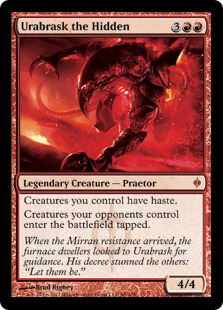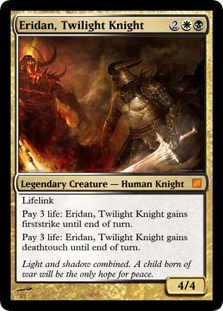This is a list of the most common abilities in Magic The Gathering. Ability words are similar to keywords in that they tie together cards that have similar functionality. A keyword in Magic The Gathering is a word or phrase (usually one or two words) appearing on a card, used to indicate that the card possesses a certain attribute or ability. These keywords are used in place of the full explanation of the attribute or ability. Most evergreen keywords MTG abilities describe exactly what they do in the card's rules text. Some, though, are very common or would require too much space to define on the card. In these cases, the object lists only the name of the ability as a keyword; sometimes reminder text summarizes the game rule.

Dash
This ability allows the player to play the creature spells for an alternative cost. A player casting a card with dash may choose to pay its dash cost instead of the normal cost. If the dash cost is chosen, the creature gains haste until the end of turn, and is returned to its owner hand at the end of turn.
Deathtouch
Deathtouch is a static ability that causes a creature to be destroyed as a result of having been dealt damage by a source with deathtouch. In this way, for a creature with deathtouch, any nonzero amount of damage it deals to another creature is considered enough to kill it. Similar abilities have appeared mostly on green and black cards, but in most cases those abilities were functionally different (typically triggering on combat damage and/or at end of combat). This ability was first printed on a single timeshifted creature from Future Sight, Thornweald Archer. Older cards with this ability, such as Cruel Deceiver, were not changed to gain deathtouch.


Defender
Creatures with defender can't attack. This ability was formerly associated with Walls, as the creature type Wall had implicit "rules baggage" that prevented such creatures from attacking.


Double strike
A creature with double strike deals both first strike and normal combat damage. For instance, a 1/2 creature with double strike such as Boros Swiftblade would defeat a 2/1 creature in combat and survive, due to destroying it with first strike damage. It would also destroy a 2/2 creature, though be destroyed itself because the opposing creature survived the first strike to deal its own damage.

Enchant
This ability is written Enchant (quality) and appears on Auras, a subtype of enchantments. An Aura enters the battlefield attached to a permanent with the quality of its Enchant ability, and can only be attached to a permanent with that quality. If an Aura is not attached to a permanent with the required quality (such as if the object it enchants leaves the battlefield), it is put into its owner's graveyard. Like protection, the quality can be almost anything, but it normally has a permanent type associated with it, such as "Enchant creature." This ability was formerly seen in the type line instead of "Enchantment - Aura." The wording changed in the Ninth Edition core set, which introduced the Aura subtype.


Equip
This ability is written Equip (cost). It is found only on Equipment, a subtype of artifacts that first appeared in Mirrodin. A player may pay the Equip cost as a sorcery (only during his or her own main phase when the stack is empty) to attach it to a creature he or she controls. That creature becomes "equipped" and can then be referenced by the Equipment as the "equipped creature." If the Equipment is already attached to a creature, its controller may pay the Equip cost again to move it to another creature. However, the Equipment cannot simply be "dropped" by the equipped creature by paying the Equip cost. When a creature leaves the battlefield or stops being a creature by some effect, any Equipment attached to it "falls off," becoming unattached but remaining on the battlefield.


First strike
Creatures with first strike deal damage before other creatures in combat. Therefore, if a creature with first strike deals sufficient damage to kill an opposing creature without this ability, it will not suffer any combat damage from that creature in return.


Flash
Flash is the keyword of an ability that has existed as far back as Mirage. Artifacts, creatures or enchantments with flash may be played any time their controller could play an instant. Older cards with that ability have been updated via rules errata to have flash; this allows them to work with cards such as Mystical Teachings.


Flying
Creatures with flying can't be blocked except by other creatures with flying and/or reach. Flying is the most common Magic keyword, and appears in all five colors, but chiefly in blue and white. Creatures with flying are often Dragons, Angels, Birds, and other creatures that have wings.


Haste
Creatures with the haste ability are able to attack and tap to activate abilities on the turn a player gains control of them, instead of waiting until their controller's next turn (an effect dubbed "summoning sickness" prevents a creature from attacking or using abilities with the tap symbol unless its controller controlled it since the start of their most recent turn). Haste is an example of a retroactive keywording, as cards from almost every earlier set have possessed "may attack the turn (they) come into play" or "unaffected by summoning sickness," which was replaced by the word "haste." It was later changed to include untapping to activate abilities as well. Creatures with haste are most often red.


Hexproof
Hexproof is a static ability of permanents and players. A player or permanent with hexproof cannot be the target of spells or abilities controlled by that player's opponents (or that permanent's controller's opponents). This is similar to shroud, but it does not deny the player (or his or her allies) the ability to target his or her own hexproof permanents. Cards that previously had or granted this ability, such as Troll Ascetic and Imperial Mask, were errataed to have hexproof with the release of the Commander decks.


Indestructible
A permanent with indestructible can't be destroyed by effects that say "Destroy" (such as Doom Blade or Wrath of God) or by lethal damage. They can still be countered, exiled, returned to the hand or library, sacrificed, or killed with effects that give negative toughness. Indestructible is now a keyword, not anymore a quality that's true about a permanent, meaning that the indestructible ability can now be removed from a card, making it suceptible to being destroyed. Indestructible first appeared in Darksteel, chiefly among artifacts made of the titular metal, and has appeared in colored creatures in subsequent sets.


Intimidate
A creature with intimidate can't be blocked except by artifact creatures and/or creatures that share a color with it. It first appeared in Zendikar. In 2009, Intimidate was announced as an evergreen keyword to replace fear, though it did not appear in a Core Set until Hideous Visage was printed in Magic 2012.


Landwalk
This ability is written as (Land type) walk. A creature with this ability can not be blocked as long as the defending player controls at least one land with the printed land type (a creature with swampwalk can not be blocked if the opponent has a swamp on the battlefield). This ability is somewhat rare, with swampwalk and plainswalk being the most common and least common, respectively. Landwalk is not limited to the five basic lands; for example, cards with legendary landwalk, snow landwalk, and nonbasic landwalk have been printed.


Lifelink
Permanents with lifelink cause their controller to gain life whenever they deal damage. Lifelink as a keyword was introduced in Future Sight, though the ability itself already existed on numerous cards, which were all issued rules errata to have or grant lifelink. Cards with similar abilities, such as Spirit Link, were not changed in this way. Lifelink was a triggered ability when it was issued but is now a static ability due to the Magic 2010 rules changes. Cards that previously had a lifelink-like ability have been issued further errata to return them to their original functionality. Lifelink is found mostly on white cards.


Protection
This ability is written as Protection from (quality). A creature with protection from a quality cannot be enchanted, equipped, blocked, or targeted by anything with that quality, and all damage that would be dealt by a source of that quality is prevented, barring exceptions which explicitly state otherwise. For example, a creature with protection from red cannot be enchanted by red Auras, blocked by red creatures, targeted by red spells and abilities, or take damage from red sources. Note that the protection ability does not prevent effects that do not target. For example, though Black Knight has protection from white, it would still be destroyed by Wrath of God since Wrath of God does not target a creature.


Reach
Reach is an ability which allows a creature to block creatures with flying. The keyword was introduced in Future Sight, and the flying rules themselves were changed to clarify this interaction. Older cards with the ability to "block as though (they) had flying" were issued rules errata to have reach instead. Reach is found primarily in green creatures, especially Spiders.


Shroud
A player or permanent with shroud cannot be the target of spells or abilities (even his or her own). While the keyword "shroud" was introduced in Future Sight, the ability itself existed long before, first appearing on Spectral Cloak; cards which featured this ability were all issued rules errata to have or grant "shroud." Creatures with shroud are most often blue or green. Today it has been supplanted completely by the more flexible Hexproof.


Trample
Creatures with trample may deal "excess" damage to the defending player if they are blocked. For example, under normal circumstances, if a 6/3 attacker is blocked by a 1/1 creature, the attacker's 6 damage is all directed at the defending creature, despite it being only able to take 1 damage before being killed. If, however, the attacker has trample, the attacking player may choose to have the difference (in this case, 5) between the attacker's power and the defenders' total toughness "trample over" and be assigned to the defending player; this choice is to be made by the attacking player, and circumstances can arise in which "overkilling" the blocking creature is a more advantageous move. Even if the blocker does not take the damage (if it is prevented, for instance) the trample damage is still assigned to the defending player. Trample only applies when a creature with trample is attacking; if a 6/3 creature with trample blocks a 1/1 attacker, the blocker's extra 5 damage cannot be assigned to the attacking player. Creatures with trample are most often green or red.


Vigilance
Vigilance is a keyword of an ability that existed as far back as Limited Edition Alpha with Serra Angel, but was retroactively keyworded beginning with the Kamigawa block. Creatures with vigilance do not tap to attack (prior to being keywording, these creatures' rules text read "Attacking doesn't cause this creature to tap"). Most creatures with vigilance are white.






